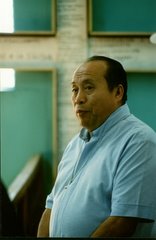One cross, two stories

ONE CROSS, TWO STORIES
This is a story about two crosses
in San Salvador. One is a cross made from
houses destroyed in the earthquake,
el terremoto. The other is the cross
that hangs by the musicians
in the Lutheran Church of the Resurrection.
This cross is the subversive cross,
La cruz subversiva. Both crosses
Come from Medardo Gómez,
the Bishop who pastors the church.
The Bishop calls the cross made
from ruins, the Cross of Life—
No es la cruz de la muerte, he says.
It’s not the cross of death.
The Subversive Cross is the cross
that went to prison. The Cross of Life
is for the Church, maybe for the library.
The Subversive Cross is for the heart,
it has other work to do. Bishop Gómez
ministers to refugees from the war,
He says he’s a refugee himself.
He says we’re all beggars.
Medardo es El Obispo de la Paz,
The Bishop of Peace, he calls his Church
a prophetic Church. Now, during the time
of this telling, a guard has been killed
at the Lutheran University. Medardo says
it wasn’t just murder, it was Death Squads, again.
Los escuadrones de la muerte, that operated
more openly during the time of the war.
The Death Squad murder of the guard
triggers the Bishop’s memory
of the Cruz Subversiva, the cross in prison.
It was November 16, 1989. Six Jesuits killed,
two co-workers dead and burned typewriters.
Then they came to get me.
·
There were pastors
from Europe and North America
acting as my shields. I went into exile
in Guatemala. They bombed my church
two times. When they couldn’t find me
they took the people in the church. 15 of them.
They took them captive. 12 foreigners,
and three people from my church.
They took my cross to prison, too.
This cross is subversive.
The cross, together with the 15,
were taken by the police.
They committed a great error here,
carrying this cross and those people to jail.
This abuse of power manifested itself
on the cross. The nation’s sins were written
on the cross to teach us and to make us
a prophetic church of liberation.
The error of imprisoning the cross
teaches us of the crimes committed
against the pueblo by the leaders.
The cross only looks passive.
Two months passed with me in exile.
Other pastors from other countries came
and accompanied me to the police.
The North American ambassador came to see me.
I saw this as an opportunity to liberate the cross.
The ambassador talked to the president
who had it delivered to the Presidential Palace.
The President then brought it to me at the Church.
I’ve got a photo of him giving it to me
pinned to the cross itself. See for yourself.
The pilgrim cross made the journey
from the carcel to the Presidential Palace
before coming home. Por eso le decimos ahora
la cruz subversiva.This is why
we call it the subversive cross.
·
Outside the Church where the Jesuits
Were slain, are these words cast in bronze
In letters 12-inches high:
Con este pueblo
No cuesta ser
Buen pastor.
With our people
There is no cost
To being a good pastor.
Giving us the cross and the stories
in the cross, Medardo sings Tantas cosas,
So many things.
There is only one cross and it’s a cross of life.
The refugees and those in the margins
have been forgotten.
Nuestro pan de cada día, our daily bread,
Crosses only look passive, Medardo says.
This cross is an invitation to walk with the poor,
he says, the job remains the same,
liberate all crosses.
Jim Bodeen
San Salvador—Yakima
February-March, 2005
Comments